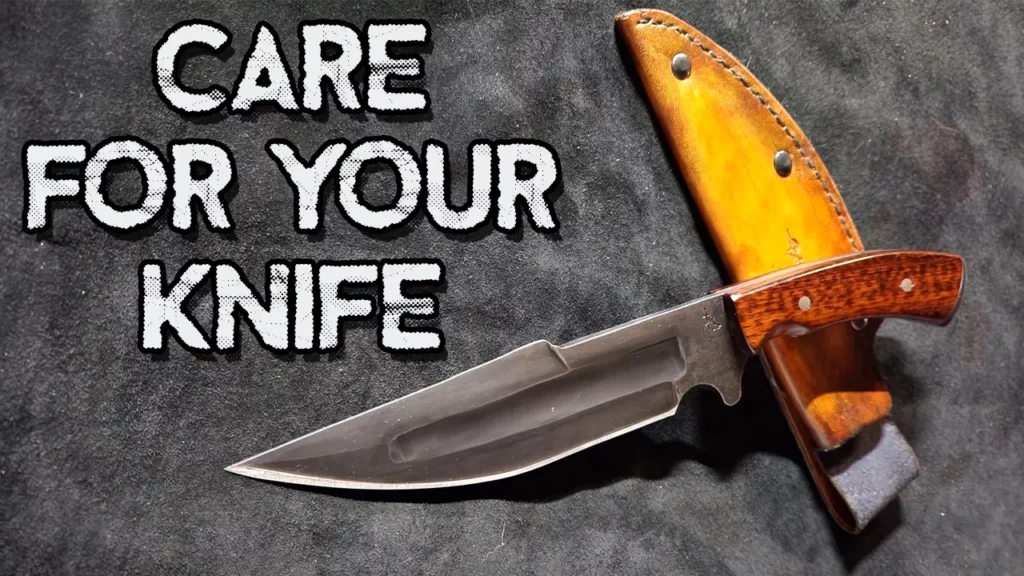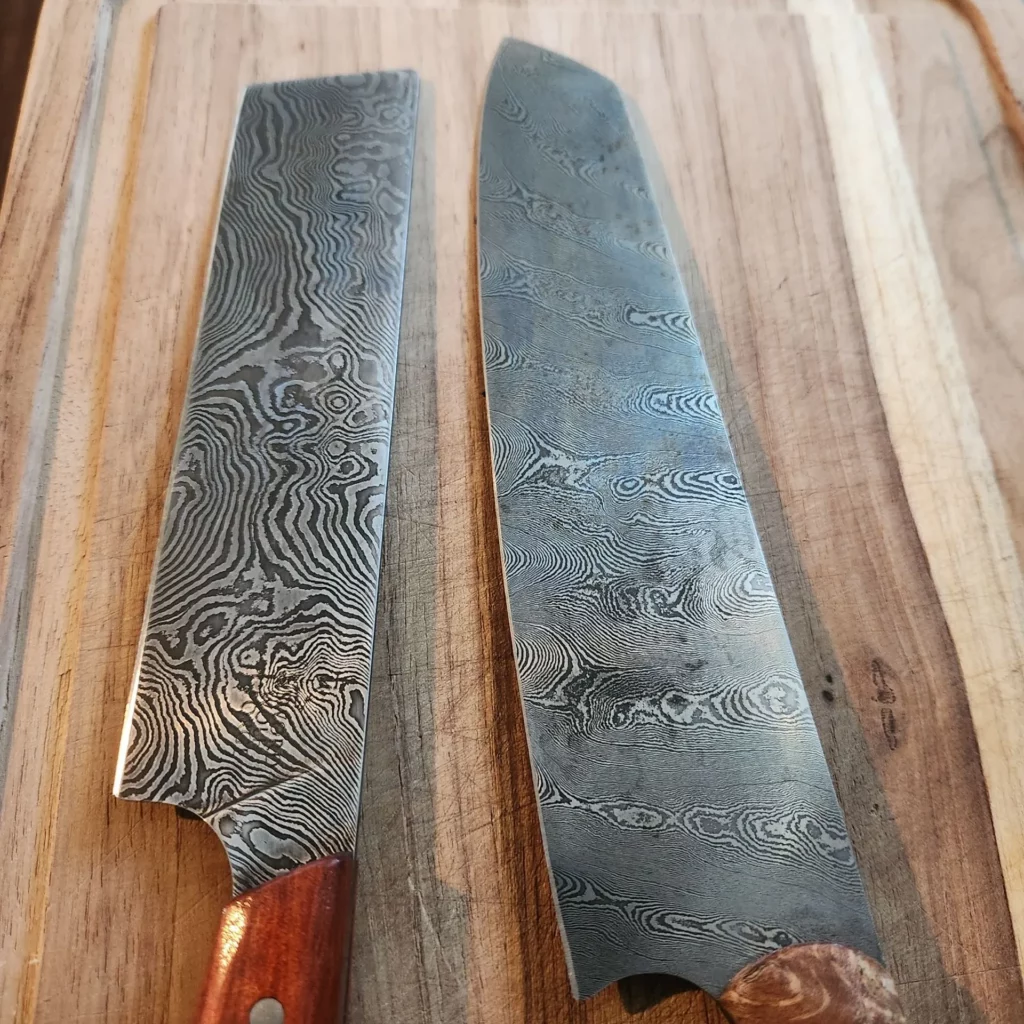
Table of Contents
Now that you just spent your hard-earned money, how do you care for your knife? Our society is conditioned to be maintenance-free and is a throw-it-away culture. I know some people who throw away their knives when it gets dull or the plastic handle breaks. That approach may be ok for a store-bought knife that cost $35 and was made on an assembly line. However, we want to take a different angle when we are dealing with a hand-crafted piece that took many hours to create and set you back more than $100.
We’re going to get into the do’s and don’ts on how to care for your knife to get the most out of it.
Prevent Rust
If you have read about my knives, I use high-carbon steels. High carbon steels are awesome when it comes to durability and holding an edge but with every pro, there is a con. High carbon steels will rust if unprotected and not stored properly. Unlike stainless steel, they do require a bit of care to keep their integrity.
A few years ago, I put one of my hunter knives into my duffle bag to show some friends. Now keep in mind, I take this duffle bag with me everywhere. So this poor bag is subject to snow, rain, your occasional coffee spill, and a few cracker crumbs. I think you understand. Well, I forgot about my precious knife after that day, and about a month later, I found it at the bottom of my bag. My little hunting knife, still in its leather sheath, had fine dust all over it from previous snacks and daily dirt. And to my dismay when I removed the knife from the sheath, I found a rusty mess! I quickly fixed it with a couple of passes on my grinder and a light coat of oil but the lesson learned here is to keep your knife oiled and do not store it in your leather sheath.
Keep It Oiled
To maintain your steel, make sure you wash and dry it well after each use and apply a light coat of oil before you store it. This also includes any steel in the handle area. These simple steps will keep your knife looking great.
For my kitchen knives, or any knife that comes in contact with food, I use food-grade mineral oil. This type of oil is safe for storing and will not become rancid like plant-based oils. Nothing ruins a meal, or a Saturday night, like an upset stomach.
One issue with kitchen knives I want to address is oxidation. When a kitchen knife is used to cut certain foods, mainly acidic foods such as lemons, tomatoes, and even meats, you will see a slight discoloration on the blade. You may notice it darken in some areas or develop some blue hues. This is a normal occurrence when using high-carbon steel. The acid in the food is reacting with the steel in your knife and is normal and UNPREVENTABLE! Many high-end chefs prefer this coloring or patina. It shows the knife is made of high-quality carbon steel and this gives it its unique character. Be sure to clean your knife right after each use to prevent this oxidation process from turning into rust.
Here are great examples of oxidation. These are my wife’s kitchen knives and have a beautiful patina. She uses the Nakiri (on the left) to chop vegetables and the chef’s knife (on the right) to cut meat. To see the original blades before this patina, check them out in my Showcase.

For all other knives, like my outdoor or fighting knives, I usually use CLP (Cleaning, Lubricant, Protectant), which is not hard to find. In the Marines, we used CLP by the gallon to clean our weapons. Again, you do not need to use a lot of oil, just a light film is all you need. Let it soak in for a few minutes and then wipe off any excess. Too much oil will lead to dust, dirt, and debris clinging to your knife where it will look like a sugar cookie.
Store It Properly
Now let’s talk about how to store your knife. When I left my knife in my duffel bag for a month in its sheath, it rusted like crazy. Sheaths are made for carrying a knife, not for storing a knife. Leather is like a sponge for moisture and traps that moisture with your knife causing our friend, rust. If you are going to store your knife for any time, make sure it has a light film of lubricant and is out of its sheath.
To store my kitchen knives, I invested in a magnetic wall mount. These attach to your wall by sticky tape or by screws. I like this option for a few reasons. The first is that I can display all of my custom knives on the wall and they are easy to reach. Don’t hide your beautiful 180-layer Damascus knife in a wood block! The second reason I like this method is that I don’t have to worry about my knives getting beat up inside a kitchen drawer.
For all other knives, simply store them in a clean and dry location and out of the sheath. I display a few of my knives on my mantle and also have a few on a bookshelf propped up on its sheath for easy viewing. One thing to keep in mind is that even if you are not using your knife, it can still rust due to humidity so it’s wise to check on them periodically.
Not The Dishwasher
The dishwasher is a death sentence for a handmade knife for a variety of reasons. If your knife is made of high-carbon steel, it can rust due to poor drying cycles. I have heard horror stories of customers taking their lovely, Damascus kitchen knife out of the dishwasher and the blade is covered with rust spots. Also, many of my knives have natural materials in the handle construction and they can warp or become damaged in humid conditions. The high heat can also cause the epoxy glue used to affix the handles to become brittle or frail.
Oh boy…
To save yourself from this bad experience and care for your knife properly, be sure to wash your knife by hand in lukewarm water using a mild soap, rinse the blade thoroughly, dry it with a soft clean cloth or towel, and then apply the proper lubricant for protection. To protect wood handles, I prefer to use a food-safe wood wax paste with beeswax, such as Wicked Wax. It protects the wood, gives it a nice shine and I love the smell!
But I Saw This On TV!
The other day I was watching one of my favorite TV shows, Forged in Fire. If you are not familiar with this program, here are the basics. They have a contest where 4 knife makers are brought into a forge and tasked with making a ridiculous knife in a very short time. After each knife is scrutinized by the judges, they do their best to destroy it through several gruesome and impractical tests. Some of these tests range from stabbing an ammunition can, smacking a truck bumper, hacking into a huge block of ice, or hammering through a steel plate.
All of these exercises are great for TV but they are not what a knife was designed for nor should they be abused in this manner! This will lead us to our next section. What is a knife designed for?
The Right Tool For The Right Job
The knife is one of the oldest known tools to man. The earliest knives were made from flint or bone. Next, man discovered better materials such as copper and bronze. Centuries later, iron was used, and then finally steel. My point here is that for thousands of years, man has always found a need or use for a knife. It’s not a technology that has been made irrelevant or faded over time.
The knife was designed to cut, stab, puncture, slash and chop. It was not designed to be a screwdriver, a pry bar or an ax and should not be used to open paint cans, chop bricks, or hammer nails. All of these activities will surely void the warranty, possibly injure you or someone else, and prove to be a big waste of time and resources.
Use your knife for what it was designed for. In a future blog, I will discuss different knife designs and their purpose.
Keep It Sharp
I have heard that a cut from a dull knife is more serious than a cut from a sharp knife. I have not personally tested this theory but it makes a lot of sense. The reason behind this is a sharp knife has a clean and refined edge that separates and pushes cleanly through the material. A dull knife, on the other hand, has a blunt edge so it tends to tear material as it passes through it. That being said, keeping our knife sharp is another strategy to properly care for your knife. We want to keep our knives in tip-top shape so when we have a task to perform, we can accomplish it. A sharp knife requires much less effort when cutting or slicing thus it is safer, cleaner, and much more efficient.
Most of the time, a simple stropping on a piece of leather is enough to bring life back to the edge. If the edge does require more attention, I suggest refraining from using a machine or a pull-through sharpener. These usually will not match your existing angle and tend to leave gnarly scratches down the blade! I prefer to use a fine stone to refresh the edge and then a quick strop. If you do not have access to these tools, I suggest asking the maker to touch up the edge or take your knife to a professional. Since there are many facets to knife sharpening, I will address sharpening in more depth in a future blog.
The Fundamentals In Care For Your Knife
We have discussed a lot of information on how to care for your knife so here’s a quick recap:
- Keep your knife clean and oiled
- Patina is normal
- Store your knife in the open; not in your leather sheath
- Hand wash; stay away from the dishwasher
- Do not attempt Forged in Fire at home
- Use the right tool for the right job
- Keep your edge sharp
- Apply a paste with beeswax to the wood parts
So there you have it! Taking the right steps to care for your knife will ensure many years of great service and provide your family with an heirloom that can be passed down for generations.
Thank you for sharing your time with me. If you have questions or want to learn more, message me.
Remember, take care of your knife, it may just save your life one day!